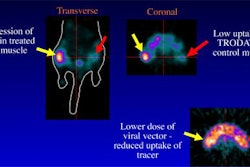LOS ANGELES - Researchers from Lawrence Berkeley National Laboratory believe they've hit upon an algorithm that will reduce patient motion artifacts, and produce more finely tuned PET images. Dr. Jinyi Qi from the Center for Functional Imaging at the Berkeley, CA-based lab discussed his group’s work this week at the 2002 Society of Nuclear Medicine meeting.
One proposed method of motion correction is event-by-event rebinning, first suggested by Margaret Daube-Witherspoon in 1990, Qi said. Rebinning involves data transformed into 2-D, slice-oriented datasets that are reconstructed with an iterative reconstruction algorithm. While rebinning is a simple algorithm that can be easily implemented, it does have a major drawback: Event-based rebinning can result in missed data caused by artifacts from patient motion.
"In the event-based rebinning method, each event is corrected for motion by proper translation and rotation. Normalization is done by weighting each event by its normalization factor," Qi said. However, this method only works when there is no missing data.
"It works when all the lines of response (LORs) in the sinogram always have finite normalization factors during the scan. The simple rebinning method doesn’t work if the patient motion causes some LORs to be undetectable," Qi said. This happens when the patient has cross-plane translation and/or rotation. Because the rebinning method is event driven, it has no way of determining that it has missed an event, he added.
The problem lies with the normalization process, which Qi’s mathematical model corrects with an algorithm that normalizes the data over the duration of each LOR.
In a simulated study, Qi and his co-investigators imaged a uniform cylinder with an 83-cm ring diameter placed in the scanner. Images were reconstructed beginning with a 2° rotation and continuing to 10° . As the rotation increased, so did the artifacts, but using the algorithm enabled the missing data to be accounted for during reconstruction.
"We have to normalize the data by integral for each line of response. The important issue here is that this integral has to be computed over the whole scan duration for each LOR," Qi said. "This method of detection is not event-driven, and the resulting image is free of artifacts."
By Shalmali Pal
AuntMinnie.com staff writer
June 21, 2002
Copyright © 2002 AuntMinnie.com




















